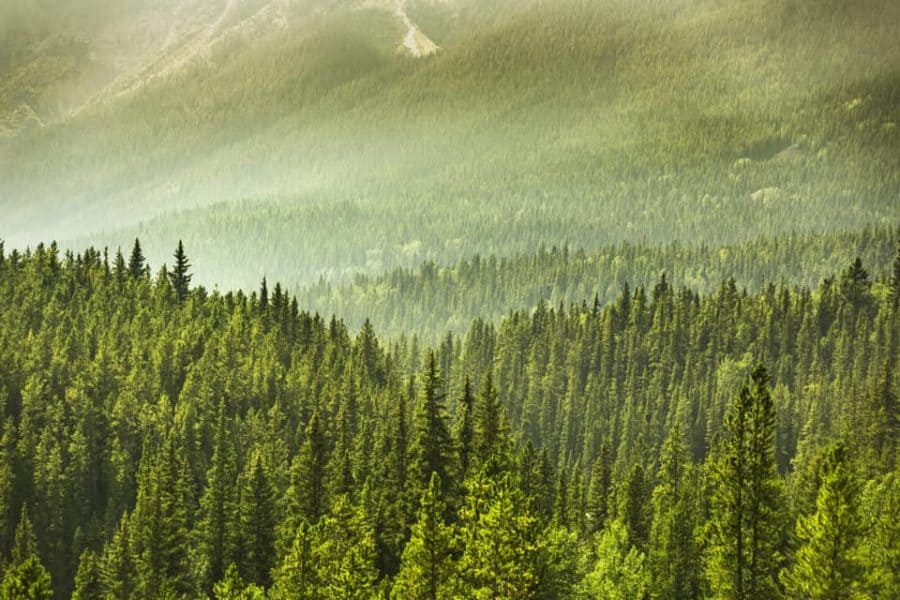Carbon dioxide in the atmosphere fuels plant growth. As carbon levels rise, it’s appealing to think of supercharged plant growth and massive tree-planting campaigns drawing down the CO2 produced by fossil fuel burning, agriculture and other human activities.
New research published March 24 in Nature, however, suggests that when elevated carbon dioxide levels drive increased plant growth, it takes a surprisingly steep toll on another big carbon sink: the soil.
One likely explanation, the authors say, is that plants effectively mine the soil for nutrients they need to keep up with carbon-fueled growth. Extracting the extra nutrients requires revving up microbial activity, which then releases CO2 into the atmosphere that might otherwise remain locked in soil.
The findings contradict a widely accepted assumption that biomass and soil carbon will increase in tandem as more plant biomass falls to the ground and turns into organic matter. By analyzing data from 108 previously published experiments dealing with soil carbon levels, plant growth and high concentrations of CO2 in the air, the authors were surprised to find the opposite.
“When plants increase biomass, usually there’s a decrease in soil carbon storage,” said lead author César Terrer, a fellow at Lawrence Livermore National Lab who worked on the research as a postdoctoral scholar at Stanford University.
Terrer and colleagues found soils only accumulated more carbon in experiments where plant growth remained fairly steady despite high levels of carbon in the atmosphere. “It proved much harder than expected to increase both plant growth and soil carbon,” said senior study author Rob Jackson, a professor of Earth system science in Stanford’s School of Earth, Energy & Environmental Sciences (Stanford Earth).
Widely used climate projections today don’t account for this tradeoff, Jackson said. As a result, they likely overestimate the potential of land to draw down carbon dioxide from Earth’s atmosphere.
Plants and soils together currently absorb an estimated 30 percent of the CO2 emitted by human activities each year. Predicting how the underground portion of this carbon sink will change in the coming decades is especially important because carbon absorbed by soil tends to stay there for a long time. “When a plant dies, some of the carbon that accumulated in its biomass may return to the atmosphere. In soils, carbon can be stored for centuries or millennia,” Terrer explained.
The work builds on research Terrer, Jackson and colleagues published in 2019 estimating that a doubling of atmospheric CO2 from pre-industrial levels – as expected by the end of this century – will increase plant biomass by only about 12 percent. In other words, plants will likely play a far less significant role in drawing down carbon than previously predicted.
Now, by examining how carbon storage works in plants and soils together, the scientists have found that expectations for another piece of the climate puzzle also need to be revised. “Soils store more carbon worldwide than is contained in all plant biomass. They need much more attention as we project the fate of forests and grasslands to the changing atmosphere,” said Jackson, who is also a senior fellow at the Stanford Woods Institute for the Environment.
The research suggests grasslands may absorb unexpectedly large amounts of carbon in the coming decades. Under a scenario where atmospheric CO2 doubles pre-industrial levels the researchers estimate carbon uptake in grassland soils will increase 8 percent, while carbon uptake by forest soils will remain roughly flat. That’s in spite of CO2 enrichment giving a greater boost to biomass in forests (23 percent) than in grasslands (9 percent), partly because trees allocate belowground a relatively small portion of the carbon they absorb.
“From a biodiversity point of view, it would be a mistake to plant trees in natural grassland and savanna ecosystems,” Terrer said. “Our results suggest these grassy ecosystems with very few trees are also important for storing carbon in soil.”
Rob Jackson is the Michelle and Kevin Douglas Provostial Professor at Stanford Earth. Coauthors are affiliated with Indiana University, Bloomington; Northern Arizona University; Oak Ridge National Lab; University of Exeter; University of California, Berkeley; Lawrence Berkeley National Lab; ETH Zurich; Swiss Federal Institute for Forest, Snow and Landscape Research WSL; University of Minnesota, St. Paul; Western Sydney University; University of Cambridge; University of Oxford; Washington State University; California Institute of Technology; University of California, Los Angeles; and University of Antwerp.
The research was supported by Lawrence Livermore National Lab, the U.S. Department of Energy, California Institute of Technology and NASA.
To read all stories about Stanford science, subscribe to the biweekly Stanford Science Digest.
Media Contacts
Josie Garthwaite, School of Earth, Energy & Environmental Sciences: (650)497-0947; [email protected]
Rob Jackson, Department of Earth System Science: [email protected]
César Terrer, Lawrence Livermore National Lab: [email protected]


